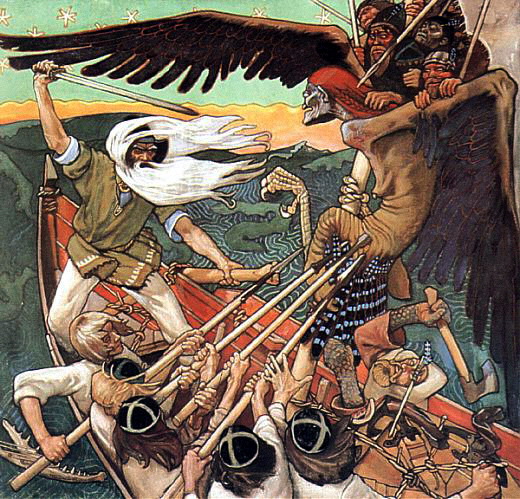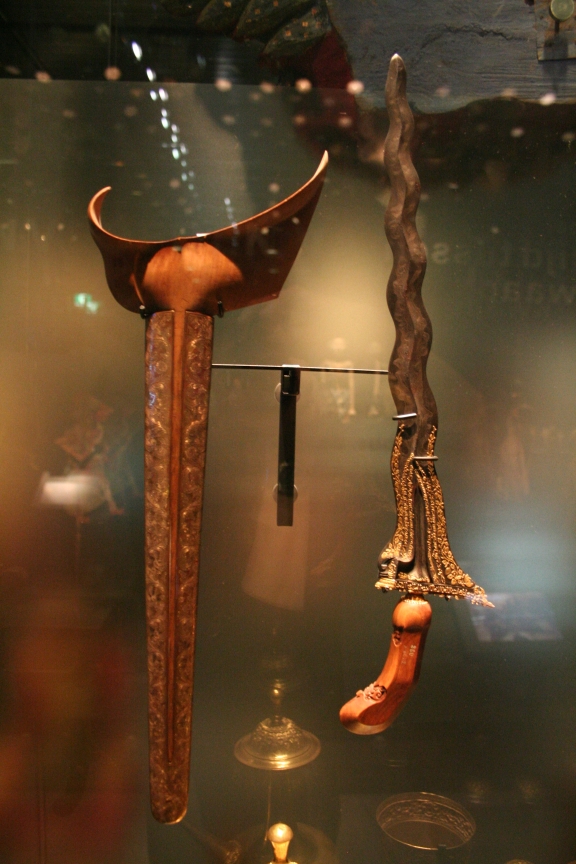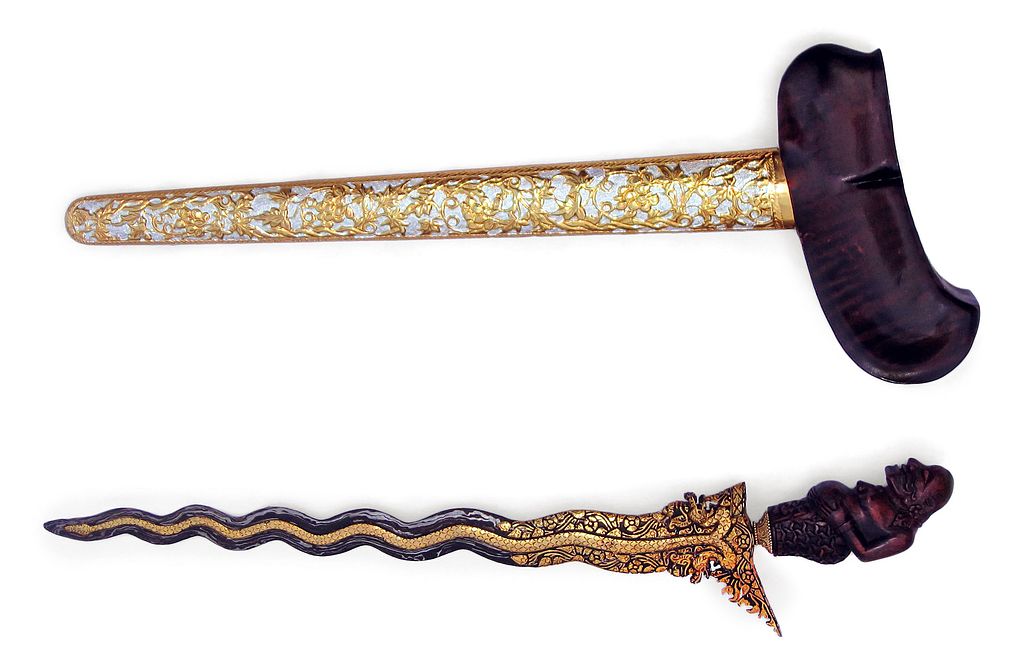
There have been no gems more beautiful yet devastating in their influences in Tolkien legendarium like the three Silmarils. Created from unbreakable crystalline substance called silima, containing the powerful Light of Valinor from the Two Trees, the gems’ immense beauty was only matched with their destructive nature. More accurately, the greed and bloodlust they invoked looked like a great contrast with the way they were created.
There are many influences that we can attribute to the nature of the Silmarils based on Tolkien’s interests and background. However, a unique parallel can also be found in an unlikely source: the semi-legendary chronicle of Javanese monarchs known as Pararaton, which features a powerful weapon and sacred object that bore a strong resemblance to the Silmarils.
The Monarch and the Cursed Dagger
Pararaton (“The Monarchs”) was a short chronicle of several kings of Singhasari and Majapahit kingdoms. This anonymous manuscript only consists of 32 folio pages, and might be written between the 15th and 17th Century. Historians do not consider Pararaton as a full historical text, with some parts of the text have mythical elements, blending facts and fictions. However, Pararaton can still be considered as a tool to understand the sociological and philosophical nature of Javanese society in the past. The most notable part of Pararaton is perhaps the story of Ken Arok, the founder of the 13th-century Singhasari kingdom in eastern part of Java.
The most notable part of Ken Arok’s story is “the curse of Empu Gandring”, involving a cursed Javanese keris (traditional dagger) simply dubbed keris Empu Gandring. There are debates surrounding the existence of Empu Gandring, but the tale of his cursed keris and the tragedy it brought bears a strong parallel with the Silmarils, the tale of their creation, and the resulting calamities.
In Pararaton, Ken Arok was described as a clever but impatient and hot-headed figure. The tale of his succession, from the foster son of a known gambler and robber to the founder of Singhasari kingdom, was strongly connected to the power wielded by the keris. When he finally found work as a soldier under Tunggul Ametung, an akuwu (sub-district leader) of Tumapel region under Kediri kingdom, he fell in love with his wife Ken Dedes, a woman who was prophesied to become the mother of future kings of Java. Knowing the prowess of Tunggul Ametung, Ken Arok decided to commission a powerful keris from Empu Gandring, a renowned keris maker, to kill Tunggul Ametung.

Since the commission was special, Empu Gandring promised to finish the keris in one year. According to him, he needed time to imbue the dagger with supernatural quality that would increase its power and protect it and its owner from negative influences. The impatient Ken Arok came back five months later, demanding the dagger before the keris maker finished with his protective spell. When Empu Gandring protested, Ken Arok used the keris to stab him. The dying keris maker pointed his finger to Ken Arok and delivered his curse: that the keris will demand the blood of Ken Arok and his descendants.
Ken Arok later used the keris to frame one of Tunggul Ametung’s soldier before killing both the akuwu and the soldier. Amidst the political chaos, he appointed himself as the leader of Tumapel and married Ken Dedes. He also gathered enough power to conquer the king of Kediri and formed his own kingdom (Singhasari). However, Anusapati, the vengeful son of Tunggul Ametung, found opportunity to order Ken Arok to be killed with keris Empu Gandring (he later killed his assistant, who committed the murder, to cover his tracks).
Was it over? Not yet! Tohjaya, Ken Arok’s son from his first wife (before Ken Dedes), found an opportunity to grab Anusapati’s keris during a cockfight, stabbing him to death. He appointed himself as the king of Singhasari, but his governing caused dissatisfaction and a revolt, in which he was killed by a spear. After so much bloodbath, Ranggawuni (the son of Anusapati) ruled with more compromise from his side, creating a more peaceful period, and keris Empu Gandring disappeared mysteriously.
Tragedies of Powerful Artefacts
Tolkien placed powerful artefacts as centers in his various major stories: from the Silmarils to the Rings of Power (including the iconic One Ring). Such object even appears in “smaller” stories, like the Arkenstone that made an appearance in The Hobbit despite not being the main focus. However, the Silmarils have unique characteristics that distinguish their nature from the other previous objects in Middle-earth legendarium.
Fëanor, like Empu Gandring, was considered a notable figure among their respective worlds regarding of their skills. While both possessed actual crafting skills, they also had hints of supernatural prowess (Empu Gandring with his ability to imbue a keris with special power and deliver deadly curse, Fëanor with his ability to “capture” the light of the Two Trees to imbue the Silmarils with). They created the most beautiful or powerful objects that later became the roots of their demise. Most importantly, these objects seemed to possess special qualities that attract greed, lust, and bloodletting.
Objects of such qualities are present in various classical tales, literature works, and manuscripts, including the ones that might have lent their influences to Tolkien’s works. The most notable one is probably Sampo in Finnish epic Kalevala, a mysterious object of enormous value that brought wealth and prosperity to its owner. Sampo was created by a similarly mighty figure, Ilmarinen the Eternal Hammerer, but it was later locked securely in the mountain (like how Fëanor kept the Silmarils in a locked metal box after Morgoth murdered his father and desired his jewels). In a way, Empu Gandring had also tried to “lock away” his keris from Ken Arok before he was finished with it because of its enormous value.

The strange thing is: despite carrying the light from the Two Trees and being hallowed by Varda herself, the nature of Silmarils caused the opposite effects for those around them. Instead of a blessing from his holy light, Silmarils inspired greed and lust and pushed those who coveted them to slaughter their kin and even innocent children. They inspired the terrible Oath of Fëanor and caused more deaths even after their maker was dead. There was a unique dissonance between the common symbolism of light and the effects the jewels caused, something to question since Tolkien had praised light as a “primeval symbol in the nature of the Universe, that it can hardly be analysed” (Letter 148).
Prof. Verlyn Flieger, in her essay The Jewels, the Stone, the Ring, and the Making of Meaning, described the development of Silmarils in Tolkien’s legendarium to explain its nature. In the first Book of Lost Tales, which contains the early version of The Silmarillion, Silmarils did not have the “sacred light bearing” nature like the version we knew. While Fëanor might imbue them with the light from Silpion and Laurelin (the Two Trees in early version), he made it to answer a challenge to create the most beautiful gems. The trees were later killed in a completely unrelated incident, and there was no thematic link between the jewels and the trees. Therefore, the presence of the Silmarils at the beginning was signified by greed and lust.
The second Book of Lost Tales showed a change in the nature of Silmarils. When Tinúviel’s father Tinwelint (Thingol) ordered Beren (an Elf in this version) to bring him a Silmaril from Morgoth’s crown, the jewel was depicted as having a holy magic, connected to the time in Valinor before evil came, which showed the thematic link between Valinor and Silmarils. In the newest version, Varda hallowed the jewels so those that did not deserve them would be burned.
The Silmarils warped the lives of those involved with them; directly and indirectly, physically and psychologically. They corrupted characters, pushed them to war and murder, burned them, and caused their deaths. Despite being imbued with holy light and hallowed by a Vala, they “somewhat” created the long line of destructions behind. In the end, the jewels did not end in anyone’s hands: one was thrown into the sea, one was burned with its holder in the earth’s chasm, and one became a star.



I said “somewhat” because there were influences from the characters’ nature and behaviors. Just like how Tolkien blurred the line between Morgoth’s curse and Turin’s name changing, we must also consider the actions of various characters like Fëanor and his sons, Thingol, and the Dwarves of Nogrod, for examples.
The same can be said with keris Empu Gandring, especially if you consider the meaning of keris in Javanese culture. While it generally belongs to other ethnicities in and outside Indonesia, Javanese keris is regarded as both weapon and spiritual object, even now. During peaceful times, keris is regarded as a decorative display, social status indicator, ceremonial object (including for traditional wedding), talisman, and pusaka (sanctified heirloom). There are even rules about the way to wear it on the hip and how to clean it.

A traditional keris maker imbues certain power and qualities to each dagger through elements like patterns, decorations, colors, and materials of the bilah (blade), hulu (hilt), and warangka (sheath). The mpu/empu in Empu Gandring is actually a honorary title given to a smith with special skill to create a keris, and according to Javanese traditional belief, an empu also needs to have spiritual prowess (a thing that separates them from regular smiths who make machetes or knives, for example). This has created various depictions of powerful keris in Javanese folktales, like Setan Kober (which was covered by its owner’s intestines in a fight) and Condong Campur (believed to be made by 100 empus).
The Silmarils and keris also had similarities in the nature of their materials. Fëanor fashioned a special crystalline substance to make the rarest, most beautiful gems. Meanwhile, the best and rarest keris daggers are not made of regular iron, but meteorite iron, which resulted in unique patterns (pamor) on the blade that also have special meanings. In Javanese traditional beliefs, keris contains intrinsic elements of nature like earth, water, fire, and air from its making, improved by the empu‘s power. Just like the holy light that became the heart of the Silmarils, the supernatural quality in a keris is generally regarded as a positive thing. However, keris Empu Gandring was marred with blood and curse, started with the murder of the smith before he had a chance to imbue the spiritual protective power into the weapon.

Chapter The History of Galadriel and Celeborn in Unfinished Tales depicted Galadriel’s refusal to give Fëanor her hair to be made into the heart of Silmarils, since her marvelous gift of insight “withheld her goodwill from none, save Fëanor”. In the cases of both Fëanor and Empu Gandring, the darker side of the maker’s power might have created the objects’ catastrophic nature. The same thing can apply to Sampo in Kalevala, which involved threat and deception in its creation, because the enchantress Louhi forced the old sage Väinämöinen to make her one before she let him leave her land, resulting in the latter deceiving Ilmarinen into making one. This was ignoring the fact that Ilmarinen had destroyed several versions of Sampo during the forging because he deemed them as “too evil”.
In the end, the most beautiful and terrible artefacts found their “demises” following many characters in their stories. The Silmarils ended in the fire and sea, and although one became the Star of Eärendil and symbol of hope, it was also associated with loss, homelessness, and cries. Keris Empu Gandring only disappeared when the new king of Singhasari decided to “break the curse” and ruled more peacefully. The Sampo finally broke into pieces before disappeared into the earth, sea, and sky.
The Silmarils, keris Empu Gandring, and Sampo showed unique qualities in their positions as precious artefacts in their respective stories. Despite being created with positive qualities, they turned into the sources of tragedies, war, and bloodbath, corrupting and killing various characters in the process. By showcasing the artefacts in such ways, The Silmarillion, Pararaton, and Kalevala have successfully blurred the line when we, as readers, perceive both the corrupt nature of the artefacts and the acts of the characters while following the paths of destructions until all of them were destroyed or disappeared.
This post was nominated for the Tolkien Society Awards 2021 under the category of Best Article.
Sources
Carpenter, Humphrey. 2000. The Letters of J. R. R. Tolkien. New York: Houghton Mifflin.
Cœdès, George. 1968. The Indianized states of Southeast Asia. Honolulu: University of Hawaii Press.
Flieger, Verlyn. 2017. There Would Always Be a Fairy Tale: More Essays on Tolkien. Kent: Kent State University Press.
Mangkudimedja, R. M. 1979. Serat Pararaton Ken Arok. Jakarta: Kementerian Pendidikan dan Kebudayaan.
Sastrawan, Wayan Jarrah. 2020. How to read a chronicle: The Pararaton as a conglomerate text. Indonesia and the Malay World. 48 (140): 2-23.
Tolkien, J. R. R. 1983. The Book of Lost Tales 1 (ed. Christopher Tolkien). New York: Del Rey.
Tolkien, J. R. R. 1984. The Book of Lost Tales 2 (ed. Christopher Tolkien). New York: Del Rey.
Tolkien, J. R. R. 1999. The Silmarillion (ed. Christopher Tolkien). London: George Allen and Unwin.
Tolkien, J. R. R. 1980. Unfinished Tales (ed. Christopher Tolkien). New York: Del Rey.
Kalevala (English version) at Project Gutenberg. Retrieved: 20 September 2020.
